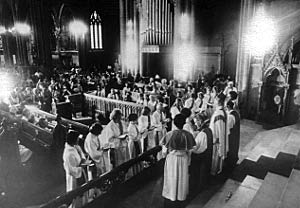Readings:
Exodus 1:15-21
Sirach 1:4-15 (in place of the Psalm)
Galatians 3:23-29
Luke 24:1-11
Preface of Baptism
PRAYER (traditional language)
I: O God of Persistent Grace, who didst call the Philadelphia Eleven to the priesthood and didst grant them courage and boldness to respond, thereby opening the eyes of thy church to the giftedness and equality of all: grant us so to hear, trust, and follow thy Holy Spirit wheresoever she may lead, that the gifts of all thy people may flourish throughout the earth, through Christ our Savior. Amen.
II: O God of Persistent Grace, you called the Philadelphia Eleven to the priesthood and granted them courage and boldness to respond, thereby opening the eyes of your church to the giftedness and equality of all: grant us so to hear, trust, and follow your Holy Spirit wherever she may lead, that the gifts of all your people may flourish throughout the earth, through Christ our Savior. Amen.
This commemoration was approved for trial use at General Convention 2024
Return to Lectionary Home Page
Webmaster: Charles Wohlers
Last updated: 8 July 2024
FIRST ORDINATION OF WOMEN TO THE PRIESTHOOD IN THE EPISCOPAL CHURCH
(29 JULY 1974)
 This commemoration marks the ordination of eleven women to the priesthood in Philadelphia on 29 July 1974.
This commemoration marks the ordination of eleven women to the priesthood in Philadelphia on 29 July 1974.
Through most of the history of the Christian Church the position of women has been secondary to that of men. During the first half of the twentieth century women in the Episcopal Church had begun exploring ways to increase their participation in the life of the church. Many women became church workers or directors of religious education or "Deaconesses" a separate order from male Deacons. The movement gained explicit momentum in 1970 when laywomen were seated with voice and vote for the first time in General Convention, and called for a vote to eliminate the canon law on Deaconesses so that male and female deacons would be treated equally.
This increased awareness led to the General Convention of 1970 eliminating canonical distinctions between male deacons and female deaconesses, allowing women already ordained to marry for the first time and to discard the old habits. It made clear that women seeking ordination would be recognized as full and equal deacons. The Episcopal Church was then presented with the issue of whether to ordain women as priests and bishops too.
A resolution was put forward by the women deputies at the 1970 General Convention to approve women’s ordination to the priesthood and episcopate. It failed to pass the House of Deputies, but nonetheless had much positive support. A similar resolution narrowly failed to pass at the next General Convention in 1973.
By July 1974, as supporters of women’s ordination to the priesthood grew restless, an ordination service was scheduled to ordain women to the priesthood by three retired bishops: Daniel Corrigan, retired bishop suffragan of Colorado; Robert L. DeWitt, recently resigned Bishop of Pennsylvania; and Edward R. Welles, retired Bishop of West Missouri. Eleven women who were deacons presented themselves as ready for ordination to the priesthood, and plans for the service proceeded. These women, called the "Philadelphia Eleven", were Merrill Bittner, Alla Bozarth-Campbell, Alison Cheek, Emily Hewitt, Carter Heyward, Suzanne Hiatt, Marie Moorefield, Jeannette Piccard, Betty Schiess, Katrina Swanson, and Nancy Wittig. They were ordained on 29 July 1974 at the Church of the Advocate in Philadelphia, PA.
The ordinations attracted immediate controversy and condemnation by many in the Church. The House of Bishops declared them "irregular" and the women were not allowed to exercise priestly functions in the Episcopal Church. Nevertheless, on 7 Sept. 1975, four more women were ordained in Washington, DC.
Finally, at the next General Convention in September 1976, the ordination of women to the priesthood was approved, to begin on 1 Jan. 1977. The previous "irregular" ordinations were regularized, and about 100 women were ordained that first year [including the web author's wife].
more at Wikipedia